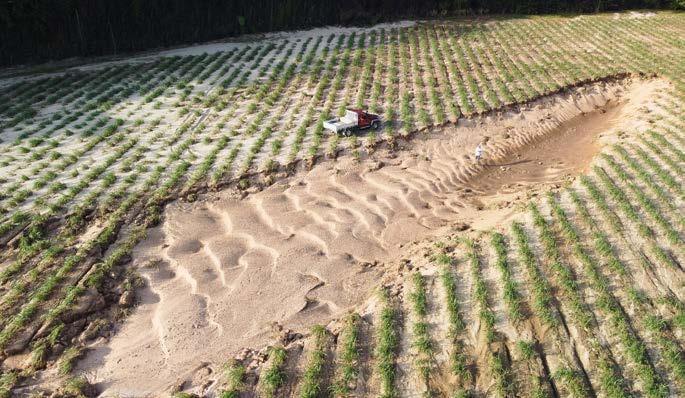
4 minute read
Counting the cost
BY RENEE CLUFF
Record-breaking floodwaters from ex Tropical Cyclone Jasper have left a trail of destruction on cane farms between Ingham and Mossman.
Matt Watson’s description of this summer’s weather in Far North Queensland sums up the situation he and many other growers have experienced. “It’s been a full-on wet season,” he succinctly said.
The CANEGROWERS Mossman Chairman is still trying to properly assess the damage, after the deluge from ex Tropical Cyclone Jasper was closely followed by a very active monsoon trough. “There are plenty of banks washed out, trees down over headlands. I’m trying to fix roads so I can get in and out of the farm. I’m trying to repair tractors that went under water but with the monsoon now here, it’s too wet to get out to do any farm work.
“There are some really big chunks of the crop that are a total write-off and there are holes big enough to fit a harvester in, but the cane that’s not too close to the river is actually looking pretty good.
“Higher up the Daintree River, it looks like a bomb’s gone off. There are massive trees that have been washed down, big sections of bank and rainforest completely washed away.
“It was the first time water has been through the mill in the 130 years it’s been there and it was 400mm deep, so switchboards have had water through them. There’s a skeleton crew working tirelessly to do what they can. The rail infrastructure is also in shambles.”
While Mossman District copped the brunt of the December deluge, parts of the Cairns and Innisfail regions also received seven-day rainfall totals above two metres, while the Tully and Herbert River regions had flooding, too.
Don Reghenzani farms in the Cairns District on the Mulgrave River at Fishery Falls. He described the situation as ‘the perfect storm’, after losing several blocks of both plant and ratooning cane.
“It was a very wet planting season, so planting was late and some of it got flooded and then it was really dry, so everything lined up to keep the cane smaller,” he explained. “Then the wet season came too early.
“It was a bloody disaster. A lot of the plant cane and ratoons were just sitting in water too long.
“Drains got filled in by the wash and had to be cleaned out, there was a lot of erosion on headlands and collapses on banks.”
At Brendan Calleja’s farm in South Johnstone near Innisfail, rushing water gouged out paddocks while dumping tonnes of sand in paddocks. “The South Johnstone River here was the highest it’s been in 50-odd years or more,” he said. “It jumped the banks and came through one of the blocks and started swirling. It made more or less two big canyons, probably eight to ten feet deep and 50 metres long. Where it didn’t physically gouge it out, the flooding deposited a fair bit of silt, and we didn’t get follow-up rain quick enough to wash it out of the heart of the cane so I’m not sure if it’s going to survive.”
Nearby, on John and Alf Strano’s farm bordering Cowley Creek, river sand and even fish were deposited on cane fields.
“In weather events like these, many creatures become displaced,” John explained. “There were 50 barramundi in one paddock—we counted them. When the water recedes, some of these animals become trapped in puddles of water. We’ve lost headlands, there is lots of creek bank erosion, and sand is smothering the cane.”
Innisfail CANEGROWERS Director and Far North Area Manager for the Queensland Rural and Industry Development Authority (QRIDA), Sam Spina, has met with impacted cane growers, travelling between Ingham in the south to Mossman in the north. Grants of up to $75,000 are being funded through a $25-million package for primary producers who have suffered direct damage. Low interest loans of up to $250,000 are also available.
“Applications are ramping up every day,“ Sam said.
“Most of the damage is in paddocks being scoured out, headlands being eroded, cane being swamped by either sand or trash. There’s also quite a bit of damage on riverbanks and creekbanks which has taken parts of headlands away.
“Longer term impacts will be a reduction in cane yield in the 2024 season and of course growers taking several years to get paddocks back to a level where they were the preflooding event.”
The Queensland Department of Agriculture and Fisheries is encouraging growers to fill out a disaster impact survey to help it assess the extent of agricultural damage so that if necessary, more assistance can be provided. The survey can be found at business.qld.gov.au








